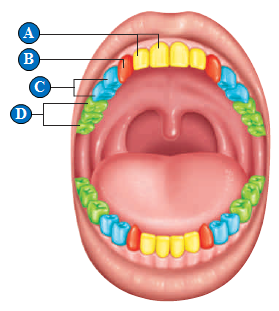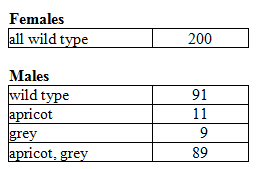
Figure 39.7A
Use the figure above to answer the following question.
The teeth designated by the letter "B" in the above figure are called ____.
A. canines
B. premolars
C. incisors
D. molars
E. wisdom teeth
Answer: A
You might also like to view...
What is the function of bactoprenol?
A) It is a hydrophobic alcohol that transports peptidoglycan precursors across the cytoplasmic membrane. B) It is responsible for forming the peptide cross-links between muramic acid residues in adjacent glycan chains. C) It triggers the recruitment of FtsZ and the initiation of the divisome. D) It supplies the energy necessary for transpeptidation to occur.
Which of the following statements is correct?
A female mouse from a true-breeding wild-type strain was crossed to a male mouse with apricot eyes (ap) and grey body (gy). The F1 mice were wild-type for both traits. When the F1 were interbred, the F2 were distributed as follows:

A) ap and gy are unlinked
B) ap and gy are linked on an autosome and 10 map units apart
C) ap and gy are linked on an autosome and 20 map units apart
D) ap and gy are X-linked and 10 map units apart
E) ap and gy are X-linked and 20 map units apart
The salinity of a small inland lake has recently started to increase. Researchers are planning to study the lake over several decades to investigate how freshwater organisms survive significant changes in their natural habitat. Which of the following physiological mechanisms will the researchers most likely observe among the surviving organisms in the lake?
(A) Prokaryotic organisms will use various mechanisms to counteract swelling of cells as a result of increased water uptake. (B) Single-celled organisms will use various mechanisms to counteract the increased flow of water from cells to the environment. (C) Eukaryotic organisms will use various mechanisms to counteract the diffusion of positively charged ions across the cell membrane. (D) Multicellular organisms will use various mechanisms to counteract the loss of cell adhesion as a result of calcium deficiencies.
Endothelial cells that line the inside of blood vessels:
A) are nonliving cells made of protein. B) are made of epithelial squamous cells. C) regulate blood flow and coagulation. D) are composed of specialized nervous tissue